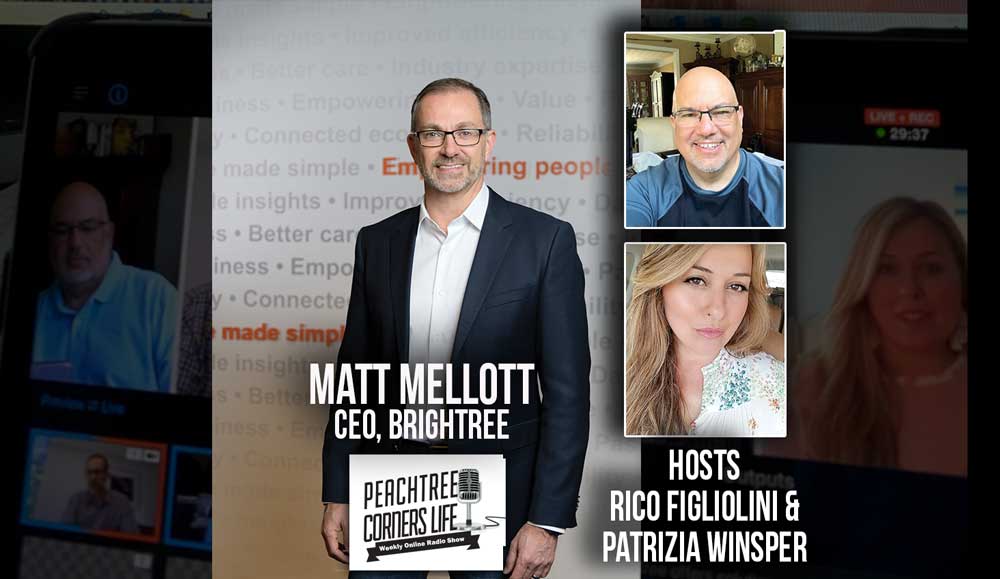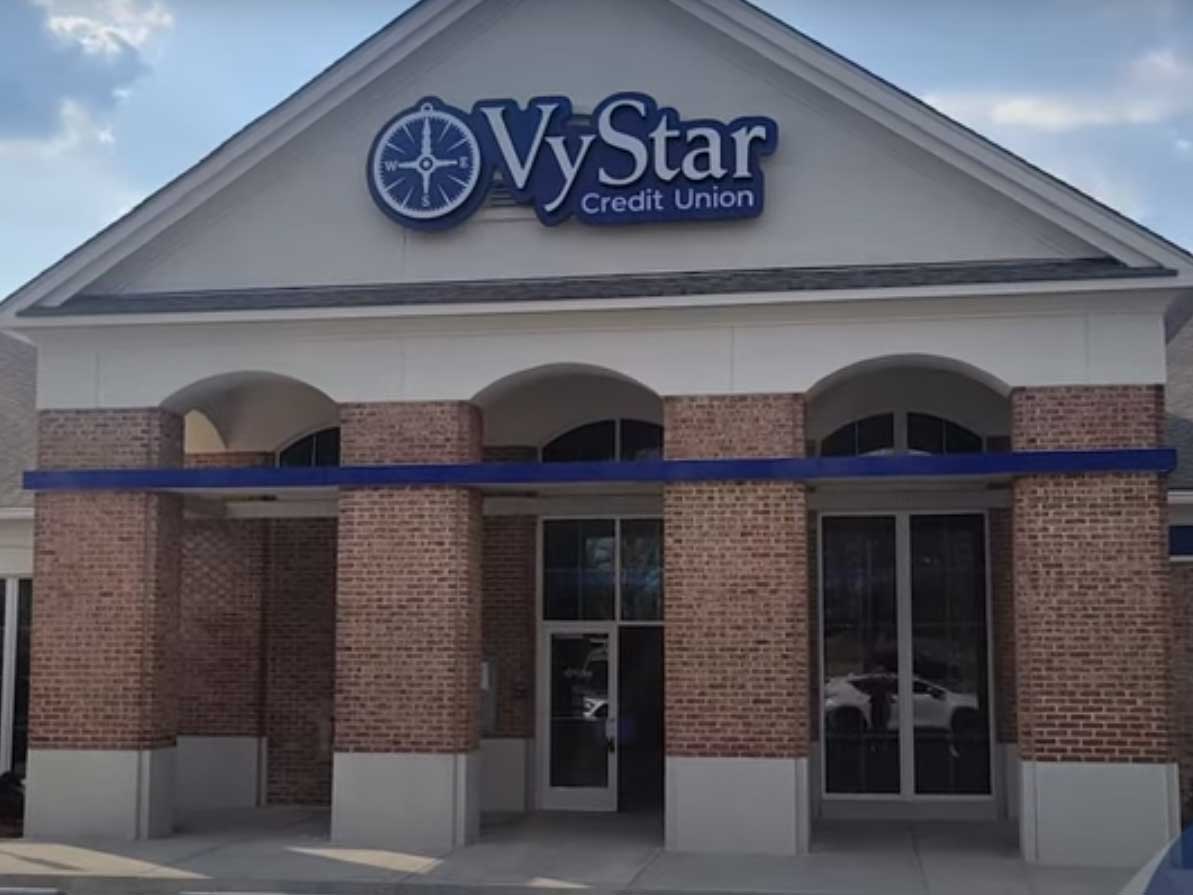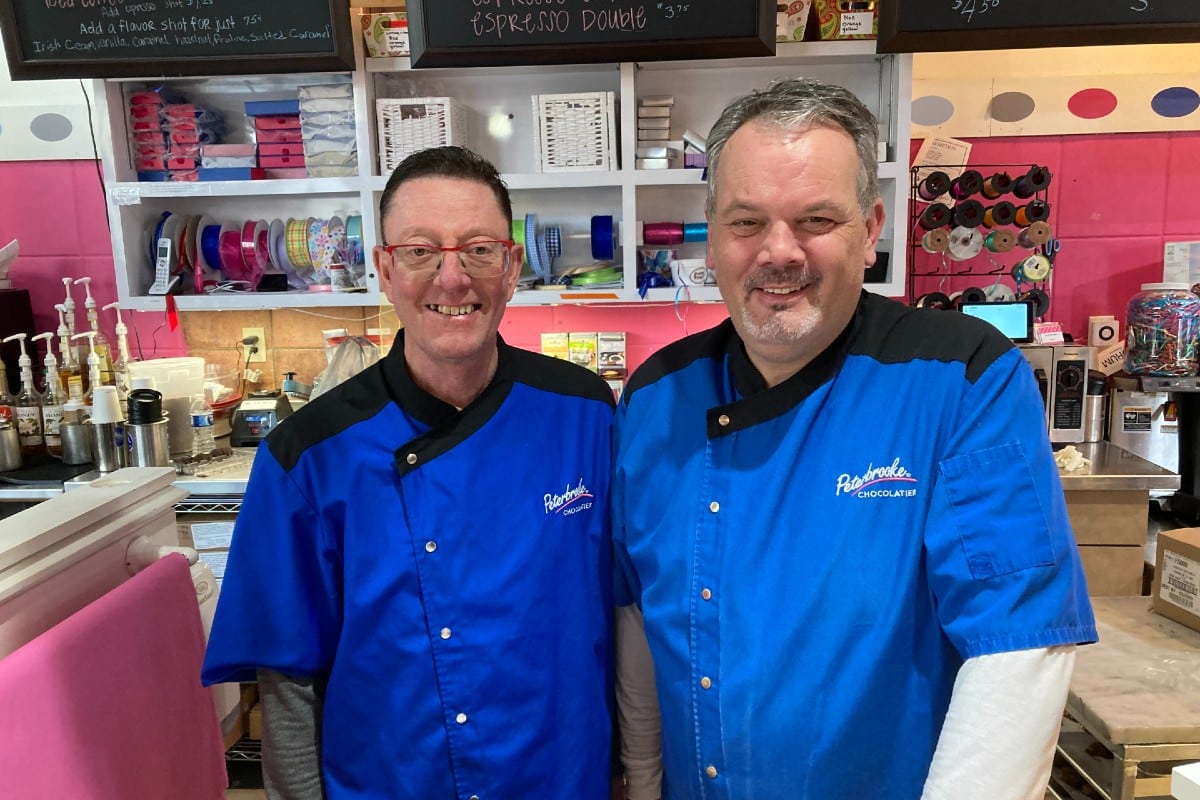Business
How to better manage post-acute care services and equipment in a changing world [Podcast]
Published
4 years agoon

As technology continues to advance and more people are working from home, companies like Brightree are making life and at-home healthcare easier. Join Peachtree Corners Life podcast hosts Rico Figliolini and Patrizia Winsper as they sit down with Matt Mellott, CEO of Peachtree Corners based Brightree and expert on the improving technologies this company is providing healthcare workers everywhere.
Brightree is a leader in cloud-based patient management software for the out-of-hospital care industry. We provide software and services to manage patient intake, scheduling, inventory, delivery, billing, clinical, resupply, and collections to facilitate better patient care.
Timestamp:
[00:00:30] – Intro
[00:03:06] – New Offices
[00:05:14] – About Brightree
[00:09:05] – How Business has Changed
[00:11:14] – Information and Data
[00:14:20] – Types of Equipment
[00:16:52] – Client Base
[00:17:49] – Modules
[00:20:10] – Consumer App
[00:22:18] – Moving to Peachtree Corners
[00:24:27] – Keeping People Engaged
[00:31:02] – Closing
“I think we’ve all been amazed and proud of our teams who have just stepped up to the cause. I mean, the collaboration, the things we’re doing, the speed we’re doing them, has just been really incredible, you know? The exciting part for me is, that we’ve learned some things here. We’ve learned how to do things more efficiently, or maybe we don’t need to do all those steps we did in the past. So how do I capture what really came out of this? That’s a great positive. I want it to be part of our culture and our DNA going forward. So we’re having some great conversations around that right now, which is exciting.”
Matt Mellott
Podcast Transcript
Rico: [00:00:30] Hi everyone. This is Rico Figliolini host of Peachtree Corners Life podcast, one of several in a family of podcasts here in the center in Peachtree Corners. So appreciate you guys showing up whether you’re watching this live or you’re paying attention to this on demand video wise, or the audio podcast for Apple, iHeart Radio, Spotify. I appreciate you being here. Follow us. Give us some reviews. Well rise up in the search when they’re looking for us. Before we get into our guests today I want to introduce our sponsor for the show and the family of podcasts and that’s Hargray Fiber. They are our lead sponsor of the company. They provide innovative solutions to a broad range of Southeast companies. They’re a fiber optic company, but a bit more than that, they provide unique solutions to businesses, both small businesses and enterprise levels, giving bundle services and a variety of other services to be out there with these large companies and smaller ones. So they’re involved in the community. They are certainly a member of the community through the chambers and other places. I’ve seen them at high schools and such. They’re very involved. They’re not the cable guy. So when you’re looking for local support and this type of work, Hargray Fiber is the company to be with. They also provide, right now, if you want to work remotely, they provide quick collaboration tools. So check them out. HargrayFiber.com and you can call them at 1-800-613-8495. So now that I’ve done that part of it, let’s get into the show. I’m going to, Patrizia Winsper my cohost for this episode is going to introduce our guests. It’s a follow up to an article that we did two issues back by a vibrant company in Peachtree Corners. Patrizia?
Patrizia: [00:02:19] Good afternoon everyone. It’s such a pleasure to see you all again today. And the man of the hour for this podcast is our cover story for Matt Mellott, who is the CEO of Brightree. Now, Brightree was originally located in Lawrenceville, Georgia, and they recently moved their headquarters to the city of Peachtree Corners. Peachtree corners has always been known for its vibrant technology, and we’re so pleased to have Brightree join us. Matt, how are you doing?
Matt: [00:02:51] Doing well. Good to be with you today.
Patrizia: [00:02:53] Thank you. It has been a while and it actually seems like a lifetime ago since we last spoke at your offices in January.
Matt: [00:03:02] With what’s going on out there. It seems even longer, doesn’t it?
Patrizia: [00:03:06] It really does seem like decades ago, but, but Matt, let’s talk about the beautiful headquarters your company has built here in Peachtree corners. It was formerly the 1970s building. It was the Honeywell property and you stepped in, Brightree stepped in and tell us a little bit about what you did there with that property.
Matt: [00:03:30] Sure. Yeah. You know, the developer really had a vision that we bought into and you know, really probably came here based upon a rendition and a picture of what it could be. Cause as many know who live in the area, it was one of the older buildings, a bit run down and hard to envision what someone could do with that property. We’ve been thrilled with what’s
happened. Parkside, you know, is the company that did the development here. We poked pretty much a sprawling complex and kept the one three story tower. That’s all that remains in a complete renovation. I think we maintained two walls and three floors. And after that, it might as well be a brand new building and, you know, very open a bit of a, you know, a loft open feel to it, much different than the space we left. You know, it’s just, it’s been incredible. Our employees are enjoying it, having spaces they can congregate in, collaborate in. So we’re just thrilled we could make the move. Unfortunately, with the current crisis, you know, we weren’t into too long until March. We ended up having to send all employees to work from home. So I know our employees are excited to get back here when we finally can bring people back to the office.
Rico: [00:04:37] It’s a beautiful office. We were there for the grand opening and it was just, that’s a great place with a lot of open space, quite frankly. So…
Matt: [00:04:46] Absolutely
Rico: [00:04:46] You should be actually in compliance with the guidance.
Matt: [00:04:51] We’re going through that now and actually get that, that’s helping. It’s actually amazing. You know, a lot of these more open, denser, places that we’ve all moved to with development actually, unfortunately are some of the problems now when we come back in and you know, it’s sort of the old offices and high cube walls are the things that would be helpful now. But you know, we’ll get through it. Hopefully it’ll be several months and things can be pretty much back to normal here.
Patrizia: [00:05:14] Absolutely. I’m sure your employees are waiting to get back and your decorators did a wonderful job. With bright, lively colors in the common spaces and that industrial two story or three story staircase pulling up that wall. It’s just gorgeous. So Matt, let’s talk about the technology behind Brightree and what exactly Brightree does. Now I can say in a nutshell that it is software based, cloud based software sorry, that helps HME companies home medical equipment companies to run more efficiently or streamline their whole business process. Why don’t you tell us in more detail about Brightree, nuts and bolts.
Matt: [00:05:54] Sure. So we’re the most widely used solution out there for HMEs to run their business on. So, as you mentioned, we’re a cloud based software solution that HMEs, home medical equipment companies will run their, almost our entire business on. Everything from the intake they take with patient referrals, referrals from physicians, scheduling their staff, scheduling patients, logistics on trucks, trucks roll out of our customers to deliver equipment to patients in their homes. Also inventory of all that equipment. And then at the end of that process is to bill payers, Medicare, commercial payers, so our customers get paid for the services they provided. So our solution really touches all aspects of that. Pretty much our solution goes down our customers are in a lot of trouble. They need it to run their business every day.
Patrizia: [00:06:46] I have to be honest, and it’s certainly within the last few weeks, I’ve been thinking of bright tree solution and wishing we could implement it on a sort of federal level, with Cuomo mentioning, you know, the huge issue of the movement of needed much needed PPE and ventilators. And he made the very wise conclusion that hospitals could no longer in, in our day and age function as separate entities, but they all needed to somehow be connected, implement communications. And they needed to be able to move the necessary ventilators and PPE on the hospitals that didn’t need it, to those who do need it. And I wonder if a solution like that would be applicable.
Matt: [00:07:36] Sure. Yeah, probably my parent company ResMed who makes respiratory devices is playing actually a role right in the middle of what you’re describing. You know, two issues that have come up through this crisis. One, not enough ventilators. And then secondly, when the ventilators are found and purchased, are they getting to the right place? So our parent company ResMed’s, they’ve actually retooled production lines to make more ventilators and actually have been recognized in the news, a contract with FEMA. So resume is playing a key role in getting ventilators, both to the US healthcare system, but ResMed’s a global company, so they’re actually know doing this to help save lives really all over the world right now. Heavy in Europe, heavy in Asia, and then preparing for other parts of the world where we’re seeing the pandemic start to take hold. On the Brightree side, you know, our customers being the home medical equipment providers. Our customers are seeing the COVID patients as they’re discharged from the hospital. You know, they’re coming home with a variety of needs. They’re needing oxygen from an oxygen concentrator. They may need a hospital bed, and they may need a walkers and wheelchairs as they recover from, you know, having COVID and being in the hospital for sometimes many weeks. And our customers are the ones now on the front lines of that aspect of the care. And we’re helping with, whether it’s home health agencies or families, you’re helping them bring equipment into the home to care for these patients as they recover.
Rico: [00:09:05] Matt, are you finding this? Have you found that the business has changed since your company has brought in all these solutions? It’s almost like an on demand, right? Someone’s leaving. You gotta have the equipment there. Everything’s all specked out on schedule. Do you see any innovations that have come along the way since you guys started doing this since your company’s been there?
Matt: [00:09:28] Yes. I’ll speak specifically in this crisis. We’re seeing, you know, probably everyone’s heard very broadly, telemedicine really taken off through this, you know, meeting with physicians and doing a telemedicine visit. So imagine now we’re, we’re seeing the same thing where equipment needs to be put into the home. Our customers, they’re being very careful with their staff. They’d like to avoid going in the home if possible. We’ve seen things like knowing the patient’s about ready to be discharged from the hospital. Our customers have requested, let us get in and out of the home before the patient comes home. Patient might still have active COVID-19. So the people who really have had a hard time getting a lot of personal protective equipment have been home medical equipment companies because the acute systems fighting for them, the nurses and all that. So the home medical equipment companies
are sort of at the bottom of the rung of getting the necessary equipment to care for these patients. So when that happens, getting in and out of the home prior to the patient getting home is key. The other thing we’re seeing happen is that they can do remote training for patients on some of this equipment. So they’re using telemedicine now in different solutions to help the patient get set up, train them, interact with the patient and their family. So I, it’s been interesting and I think, I hope medical equipment industry will see what the position industry is seeing. A lot of this technology is probably here to stay. The efficiencies of doing this are being realized and a lot of our customers are saying, we’re not going to just turn this off when this crisis is over. This really is a better way to care for patients and much more efficient. So as you can imagine, we’re a software company. We need to now work with them on those solutions. That might be done during a crisis, but there are the beginnings of what long term will be some of the solutions that we’ll have probably going into the next year and a half.
Rico: [00:11:14] Let me ask you something, because you are a software company, because it’s like, it’s almost like an IT company in a way, right? Because you’re, you’re managing all this information, right?
Matt: [00:11:23] Right.
Rico: [00:11:23] Does the information that you gathering, is that making it more efficient? Is that also helping you tweak your software to be able to address the, the demands and the challenges out there?
Matt: [00:11:33] Oh, it absolutely is. So we have an analytic slate for that we built out over the last two years that really sits on top of our platform that helps us for internal purposes, analyze utilization of certain modules or parts of the system. Because you get to kind of touched on this, through this crisis we know there’s parts of our systems that utilized, very robustly can help customers through some of the challenges they’re having. So we can help on that aspect of you really should be using the resupply, you know, for medical supplies or other portions of our system. In addition, our, we have a very rich analytics tool for our customers. We’ve created a free version of that that we rolled out for all of our customers, giving them a quick dashboard. Packing their revenue, their cash payments, sort of also to monitor the productivity of their staff. Because as you can imagine, our customers sent all their administrative folks home as well. So the manager is no longer in the room with their employees, so they now have people all over, they’re trying to say, are they efficient? Have they processed enough orders? So we’re getting analytics to help them manage that through this time.
Rico: [00:12:41] Isn’t that funny how, how the world is with computers in a room, you’re even, like you said before, with the cubicle, you can either be there, it could be somewhere else. It almost, doesn’t matter. You’re still in front of that computer right? So, I mean, measuring that efficiency is important and probably will actually not only save money for the company, but maybe reposition some of those employees in a different way.
Matt: [00:13:04] A hundred percent agree. And with our software being cloud based, that really was a plus for our customers. They literally could tell people on Thursday, pack up, go home Friday, they have an internet connection at home. They’re up and they can be seeing, you know, they’re logged into the system and seeing their cues and the work they need to do. We’re feeling it internally as Brightree as a company, and I think our customers are that, there’s probably a whole new view on work from home when this is said and done, knowing that we all made the transition. We survived, and actually in many cases as productive as we work. So I think we’ll see our customers will, that will put some demands on us to support them in that endeavor, to let more work from home. And as a business for Brightree, I think we’re going to have a much more liberal view of working from home in the future.
Patrizia: [00:13:50] Well, the circumstances are certainly unfortunate, but I’m certainly glad that you’re able and you have the capacity to do what you have been doing. And you know, today it’s the Coronavirus, and tomorrow it might be, who knows what? So, I don’t think we’re ever going to be really in the clear from whatever new virus comes out and hits the world.
Matt: [00:14:13] We’ll probably be in a whole different place of preparedness next time after, you know, hopefully we, we learned from this one and we have everything in place if this were to happen again.
Patrizia: [00:14:20] Matt, let’s dial it down just a little bit for our listeners and our viewers who aren’t even really sure about the home medical equipment that is available for being to people’s homes. Let’s talk about what types of equipment you, your clients are taking to people in their homes after a hospital stay, after a surgery, even after COVID treatment, like you just mentioned.
Matt: [00:14:43] Sure. Yeah. I’ll first cover the broad range of products provided by our customers. It starts at one end of the spectrum of the medical companies that are focused on medical supplies. This could be wound care, ostomies supplies, incontinent supplies, diabetic supplies. So we have customers are a hundred percent focused on shipping those products into the patient’s home. Then you start moving into the delivery of equipment or equipment patients might come into a retail site and pick up and take home talking about oxygen concentrators, oxygen tanks, C-PAP equipment, C-PAP supplies, walkers, wheelchairs, bedside commodes, hospital beds. And then the range goes into the complexity of power mobility. So you’ve probably seen, you know, the power wheelchairs that have all the equipment needed for folks with special needs. You know, that could be a very expensive, complicated piece of equipment. So that also falls into what some of our customers do as well. So a patient discharged from a hospital, coming out of a COVID experience in the hospital could use a variety of that equipment I just mentioned. That needs to be taken into the home needs to be assessed, you know, to make sure if there’s training involved and the patient can’t receive that training, is there a caregiver or relative? So really assessing that the home environments even conducive to the equipment that’s being taken into that home. And then the ongoing therapy or adherence to that therapy if they need to be using the device every day on that, making sure that the patient’s
using it, and a lot of times there’s a lot of data coming from those devices that our customers can monitor that and they know when to, you’ll go to the home or call the patient that if there’s an intervention necessary.
Patrizia: [00:16:25] I also recall you mentioning medical experts or people who help with rehabilitation professionals are coming to visit the home as well as the equipment.
Matt: [00:16:38] That’s correct. So, respiratory therapists in particular with a lot of this respiratory equipment and also related in the COVID patients as well, will be ones who will care for the patient in the home and assess how they’re doing on that equipment.
Patrizia: [00:16:52] And your client base is interesting. You have everything from the small mom and pop HME companies to large companies with a coast to coast presence. Tell us a little bit about your client base.
Matt: [00:17:05] Sure. No, I think you’ve covered it. Brightree really got its start from helping the small mom and pop home medical equipment company and then it’s just grown over years as the product has more features and functionality to the point now, as we’ve talked before, two of the national HME companies utilize Brightree you know, for running their operations. Just as you can imagine, very different needs from a, you know, a large national coast to coast company than one who has two or three users on our system. So definitely, you know, makes managing and also making sure the right features for the right customer there as a complexity to it. But, you know, we’re, we’re thrilled that, you know, that much of the industry can really find use and value in our system.
Patrizia: [00:17:49] To be able to serve such a diverse base of companies you have come up with modules to actually, address the specific needs of a certain company. So why don’t you tell us a little bit about your module?
Matt: [00:18:02] Sure, sure. So Brightree as its core component, if you will, that can take the intake of patients, manage inventory and get those out the door. But we have a variety of modules that customers can pick and choose if they need one for example, being for those who sell over in the medical supply business. If you do a lot of diabetic supplies or incontinent supplies, we have a special module that does the automated phone call to a patient and a patient can order by responding to that phone call. We have solutions that are just for C-PAP resupply that call centers can use to call patients and help them with their resupply needs. We have another module that our folks who, customers who run trucks can use, helps them with logistics on route planning and also helps them with a paperless interaction with customers. you know. So no paper, they can come back and just, you know, the files are automatically uploaded into the system. In addition, we also have a variety of services we offer our customers as well. Some have outsourced their billing to our revenue cycle management services, and then we also have, call center services. So some customers can outsource their call center for a medical supply replacement. We can help them with that as well.
Rico: [00:19:15] Are there any areas that you’re planning to add into this as well that you’re looking forward to?
Matt: [00:19:20] At the moment we also have a rather rich ecosystem where if we say don’t build it or buy it from a module standpoint, we look for folks that might be best in class in the industry, and we will work with them on an integration. Since Brightree is, you know over 50% of the market is using Brightree. That’s an attractive proposition to someone who comes to the home medical equipment industry and says, Hey, I have a great solution. So we’re looking at those out there. We recently did one with a company that does nothing but focus on equipment repair, which has actually been a very manual process for our customers. They’re doing an integration with a company like that. Don’t own it, it’s just a partner relationship. We allow our customers to live within Brightree, get access to other modules and features and services by just linking them up to the Brightree ecosystem through an integration.
Rico: [00:20:10] That’s an excellent value added. You know, you know what I’m also thinking that an app would be a great thing as well for those individuals that are receiving this stuff to be able to track it themselves. The consumer facing app that would be able to like look at the equipment coming to them and stuff.
Matt: [00:20:26] So about a year ago, we actually released that the trade show for home medical equipment are App, patient engagement app called Patient Hub. What it is, it’s a Brightree generated app, but when our customers use it, you know, it’s basically personalized and their logos go onto it. The patient can do direct, secure messaging with their provider. They can do appointment checks, they can pay a bill, they can order supplies. So yeah, it’s funny you do mention that we’ve seen an uptick in the interest and the adoption of that feature through this because of the inability to really interact face to face with customers.
Patrizia: [00:21:05] They really thought of everything, Rico haven’t they?
Matt: [00:21:12] We’ve been doing this for a long time.
Patrizia: [00:21:14] America needs you. When I last spoke with you, Matt, you had just publicly launched analytics. How has that worked out for you? I understand that it was adding functionality and access to data for your customers. How has that been working?
Matt: [00:21:32] It’s gone very well. And I, you know, customers who have bought that module or that solution are really getting all kinds of new insights into their own data. And we provide benchmarking as well, so they can compare how they’re doing to others in the industry. And as well, as I mentioned earlier on, we created sort of a scaled down version of that, that we’ve rolled out to customers for free during this crisis saying, just please use this solution. You’ll find tremendous value in monitoring your business and how it’s doing. So, to be quite honest with you, the web, once we get to the other side of this crisis, I’m expecting quite a bit of interest or
along, it’s already happening along the way of, you know, could they look at the full blown solution? You know, even before we get to the end of this.
Patrizia: [00:22:16] Fantastic.
Rico: [00:22:18] What about the challenges? You know, obviously let’s, let’s take it a little broader now. You’re centered in Peachtree corners. You guys moved from Lawrenceville. What other reasons also are, not that a major reason, but employees, right? They have to come from somewhere. Sometimes it’s easier to pull them up from Atlanta this way or from Alpharetta. It’s a little closer than Lawrenceville. Of course. You live in Peachtree Corners, I think?
Matt: [00:22:43] I do, yes.
Rico: [00:22:44] That’s even better. But, so how, has it been the challenges? I’m sure all the businesses that might be listening to this other business owners would like to know the challenges you’re facing with teleworking, putting your people out to the, we touched on it a little before, but maybe we get a little bit more into that.
Matt: [00:23:04] Sure. And this started for us when we made the move. As you can imagine, when you move anywhere, in no traffic probably 25 minutes from Lawrenceville, where our old office was. And as you could imagine, people have moved to the other side of the office further out into, you know, Grayson and areas like that. So when we moved, we put a commute or a transportation burden on many of our employees who lived even, even further out. So at that time to you know make sure that everyone was excited about the move. We actually started adopting a rather a more liberal work from home policy than we had before. So in a way, it was a bit of a dry run for what happened in March when we had to turn that on for 550 employees, 150 of which were here in Peachtree Corners. So recommendations for an office move, if you know that being, the question is the ability to be flexible with the workforce. You know so that we don’t lose people just for the sake of, I’ve added 25 minutes to their drive. You know, we really were able to do things to allow them to work from home, be in the office during certain hours where teams do need to meet, you know, discuss what they’re doing, in software development, for example. But it gives them a lot of freedom outside of that. I think when this is over, we’ll find many other departments who would say they didn’t think that would work for them. They found it’s working for them. So I think we’re going to have some very interesting dialogue when we get back together on how we do this longterm.
Rico: [00:24:27] How are you keeping, how are you, how are you keeping them engaged and excited about what they’re doing? I mean, zooming all day long could be, could be a problem with some people, but we’ll keep…
Patrizia: [00:24:43] You in the studio right now in Atlanta Tech Park, but you know, we’re social distancing and doing the right thing for our well-being. So, yeah. Good question, Rico.
Matt: [00:24:52] Yeah. I am, I’m sure many people are in the boat I’m in. It’s back to back zooms all day. And that has its challenges. You find if you don’t schedule time for lunch, you know, you’re not eating it or you’re eating it on a zoom, which isn’t ideal. So you got to just think through the small things. But what we’ve done though, to connect with the employees during this time, you know, your question is, we do town halls quarterly, you know, where it’s an all employee and we get on and we do a presentation. We’ve gone to every two weeks on that. And the reason being is, you know sharing a lot of what we talked about on this call is, what’s going on with our customers? What are we doing to help our customers? What’s the impact this is having on Brightree? So we’ve just been very transparent and doing that every two weeks. And so that’s been great. We’ve gotten a lot of feedback that they appreciate that. The other thing we’ve done is we’ve got. A group out there who’s constantly surveying our employee base. So what’s the thing they want to know next? What should I answer on the next town hall? We just did one recently said, what are you thinking about when we ask you to come back to the office so we can get all the concerns from the employees. We’re hiring through this as well. And that’s a challenge. You’re hiring an employee that we’ve maybe have interviewed the hallway through. Made an offer and they’re starting and we’ve never been face to face, so those employees were keeping a real close eye on. We’re hooking them up with mentors who are not their supervisors, so they can reach out and say, you know, how do I use the solution to get on the zoom call today? Or, you know, whatever the case may be, that they’d be embarrassed to ask that they’ve got a link to the organization other than their supervisor. We’re trying to hold a virtual, I normally have a lunch with all new employees every month. We’re going to try to do that virtually here very soon. The welcome to the company, tell them about the mission of the company. And in our parent company is great at this type of collaborations. So they produce a lot of ideas and schools were able to adopt because they’re doing this with about, you’re well over 7,000 people globally have this challenge and keeping them connected. But it’s been a challenge, but we’ve learned a lot of great things to do to just keep that connection.
Rico: [00:26:55] Yeah, it has been. I’ve been talking to a few people that handle team building leadership building and how leaders should deal with their, with their employees. And it is a challenge, right? I mean, you know, there’s one company out there in Peachtree Corners, they do a Toastmasters. I think it’s kinda neat. Now they’re doing it virtually. I mean, it’s still like you’re doing this. They’ll bring things on just in a virtual environment.
Matt: [00:27:24] Right. I know departments having virtual happy hours or they have their morning coffee together and we’ve really stressed with all of our supervisors. Make sure you’ve had at least one touch point with your employees during the week. Because I mean, as we all hear the stories, you know. Working from home, sounds good at first until there’s three kids there as well. Trying to do homework and you’re maybe trying to help them with that. You have a spouse at home as well. You know, we start adding all of these things up. Work for a lot of people at home has not become the best experience and it, we’ve been very honest with our employees. We understand that. You might tell us you can’t be as productive as you maybe were in the past. And we’re in a time where that’s okay. So let’s just, you know, we keep an eye on folks and look forward to the day we can get back into the office.
Rico: [00:28:08] I think I also find people are actually working harder and longer. Sometimes it just depends on the person because they don’t have that nine to five break. And so they’re either working earlier or later and just shifting how they’re doing some of this.
Matt: [00:28:23] Right, right. But yeah, that also comes with a downside. You know, the employee, and he’s working til midnight to make up for it because the kids distracted them during the day. And that’s the employee we want to say, don’t do that. Let’s not do that, right. Let’s, your mental health, your physical health. Ours, first of all, take care of yourself and your family, but then we want to get the best of you as well. You want to make sure that they’re in the right place.
Patrizia: [00:28:45] Nice that you say all that, Matt. Especially today on May day, it’s known as the day of the worker and workers’ rights, so. Nice of you to think of your employees that way. And my, my heart certainly goes out to all the parents who are trying to do full time or have little children in the home at the same time, true.
Matt: [00:29:01] I’ve heard this story from the other CEOs I’ve spoken to. I think we’ve all been amazed and proud of our teams who have just stepped up to the cause. I mean, the collaboration, the things we’re doing, the speed we’re doing them, has just been really incredible, you know? Now the, the exciting part for me is, you know, we’ve learned some things here. We’ve learned how to do things more efficiently, or maybe we don’t need to do all those steps we did in the past. So how do I capture what really came out of this? That’s a great positive. I want to be part of our culture and our DNA going forward. So we’re having some great conversations around that right now, which is exciting.
Patrizia: [00:29:37] Well, no one could have foreseen what would happen soon after your move to Peachtree Corners, but hopefully we’ll come out the other end of this tunnel in a somewhat reasonable amount of time. Let’s talk about why you did choose Peachtree Corners, though. I know that it increased your pool of employees, right? You can now draw from Midtown or from Alpharetta, and people did have more convenient commute, but what were some of the other perks about becoming part of the Peachtree Corners community for you?
Matt: [00:30:06] Sure. You know, definitely we weren’t very close to anything with great shopping and restaurants. You know, what’s been going on and be street corners with town center was a huge plus. You know, just being welcomed into the community and being part of Tech Park and what’s going on, you know, over here, you know, in terms of that it’s been great. So I think there were a lot of just attractive features to it that the employees were really able to appreciate. And just what we were able to do with the building as well, have large areas that we could gather, an outdoor area. You know, features we just did not have in the old building, which was a, you know, a typical five story office building. And we had two floors, you know, very, very different environment here. So I think people really enjoyed the building as well as being part of Tech Park. And as well as, you know, Peachtree Corners
Rico: [00:30:51] Well we’d like to have you here and thank God you fixed that building. I can say that I’ve lived here since…
Patrizia: [00:31:02] He’s allowed. He’s absolutely allowed and we’re really, truly glad to have you as part of the community. Thank you for taking the time to speak with us today, Matt.
Matt: [00:31:12] Absolutely, appreciate it. Enjoyed spending time with you.
Rico: [00:31:15] Same here. So let’s wrap it up. We’re at our end of our time, so I do appreciate you guys being on Peachtree Corners Life. I want to say thank you again to Hargray Fiber for being our lead sponsor. And to those people that have been watching us, there’s more shows. We’ve been podcasting way more over the last few weeks, as you can imagine. So there’s a couple of other companies, CEO’s, we’ve interviewed a lot of other people that are out there in the community. Like Jay Hackett the pastor of Peachtree Corner Baptist. The head of school at Wesleyan, principal at Paul Duke high school. Lots of podcasts. Check out the YouTube page, the LivinginPeachtreeCorners.com and look for the next issue of Living in Peachtree Corners magazine at the first week of June. I think we’ll be out. Lots of good stories. So thank you guys, hang in there with us Matt, I’m going to close right now. Thank you Patrizia for being on with me.
Patrizia: [00:32:10] Thank you stay safe everyone.
Related
Business
VyStar Credit Union Continues Growth in Georgia with the Opening of a Peachtree Corners Branch
Published
1 day agoon
May 9, 2024
A grand opening and ribbon cutting ceremony is scheduled for May 29, 2024
VyStar Credit Union has to announced that its Peachtree Corners location is now open at 5125 Peachtree Parkway in Peachtree Corners. This is VyStar’s fifth full-service branch in Metro Atlanta and joins branches in Stockbridge, Suwanee, Smyrna and Marietta.
In support of its purpose to “Do Good,” VyStar partners with non-profit organizations across the communities it serves. VyStar will make a $5,000 donation to the Rainbow Village to celebrate the grand opening of the Peachtree Corners branch at the ribbon cutting event in late May.
“VyStar’s first branch in Gwinnett will provide residents and business owners with better banking options, including free checking, access to early direct deposit, great rates, financial wellness education through VyStar’s Financial Fitness initiative, and unbelievable member-centric service that only a credit union can provide,” said VyStar EVP/Chief Operations Officer Chad Meadows.
The Peachtree Corners branch features VyStar’s digital-forward design, which enhances how employees connect with members. This includes interactive touchscreen kiosks that provide financial tools and allow members to quickly explore the latest products, services and rates.
Lobby and drive-thru hours for the Peachtree Corners branch are Monday through Thursday, 9 a.m. to 5 p.m. and Friday, 9 a.m. to 6 p.m.
VyStar continues to work with local organizations to build up the communities it serves. In Metro Atlanta, that includes supporting the Atlanta Community Food Bank, Junior Achievement of Georgia, Frontline Housing Inc., H.E.R.O. For Children and many others.
“Each time VyStar opens a new branch, it is another opportunity for us to support our purpose to Do Good. With eight full-service branches now in Georgia and our first Contact Center in Metro Atlanta, VyStar is able to provide residents and area businesses with exceptional financial products along with personalized service,” said VyStar SVP/Georgia Market President Janean Armstrong.
VyStar has seven additional locations in Georgia: Marietta, Smyrna, Suwanee, Stockbridge, Brunswick, Savannah and Thomasville, with plans to open branches in Pooler, Kingsland and Peachtree City over the next year.
The credit union is also expanding its services in Florida with a third branch in Tallahassee scheduled to open in May followed by a branch opening in the Lake Nona area in August.
To celebrate the grand opening, the community is invited to a ribbon cutting ceremony on May 29, 2024, at 10:30 a.m. Learn more about the Peachtree Corners branch.
Related

Kendra Scott is celebrating the opening of its newest store in Peachtree Corners the weekend of May 10 at The Forum.
Upon opening, the 2,263 square foot store will display Kendra Scott’s current collections. The store will also showcase the brand’s unique Color Bar, offering shoppers an interactive experience to create customized jewelry in minutes and leave with it in hand.
Worn by celebrities including Hailey Bieber, Camila Cabello, Mindy Kaling, Zendaya and Kelly Clarkson, Kendra Scott’s collections are known for their custom-created stone shapes, genuine materials and design details.
This will be Kendra Scott’s first store in Gwinnett County, which joins five other retail locations in Georgia.

The brand will continue to show its support for the community through partnerships with non-profits and local businesses. For the grand opening weekend, Kendra Scott Peachtree Corners will host various non-profits for Kendra Gives Back events, donating a percentage of proceeds directly back to the causes.
Kendra Scott hosts more than 10,000 Kendra Gives Back events in retail stores annually and looks forward to establishing relationships and connecting with the Gwinnett County community.
“We’re excited to continue introducing the community to new brands, bites and events at The Forum as part of our vision to create downtown Peachtree Corners. Kendra Scott will be a welcome addition, providing our guests a top-notch experience to shop its unique offerings in person,” said Charlotte Hinton, The Forum marketing manager.
Doors will open on Friday, May 10, at 10 a.m. with celebrations throughout the weekend, including giveback events, gifts with purchase and giveaways. RSVP for more details here.

Upcoming events:
- Friday, May 10 from 10-12 p.m. – Kendra Scott Peachtree Corners is partnering with The Forum for a VIP event. Supporters who spend $100 will receive a special jewelry gift with purchase.* Guests will also enjoy refreshments from Giulia, The Italian Bakery.
- Friday, May 10 from 5-7 p.m. – Kendra Scott Peachtree Corners is partnering with the Norcross High School Cheer Team and donating 20% of proceeds. Supporters who spend $100 will receive a special gift with purchase* Guests can also receive a custom embroidered bow from Quiet Hours Embroidery with purchase.
- Saturday, May 11 from 4-6 p.m. – Kendra Scott Peachtree Corners is partnering with Spectrum Autism Support Group and donating 20% of proceeds. Supporters who spend $100 will receive a special gift with purchase.* Guests will also enjoy complimentary cotton candy from Wonder Soirée with every purchase.
- Sunday, May 12 from 12-2 p.m. – Kendra Scott Peachtree Corners is celebrating the Community of Motherhood. Supporters who spend $100 will receive a special gift with purchase.* Guests will also receive a complimentary Mother’s Day bouquet of flowers from Nancy’s Flower Truck.
*One per person while supplies last.
Kendra Scott Peachtree Corners is located at 5155 Peachtree Parkway, Suite 710 in Peachtree Corners at The Forum. For companywide updates and product details, follow @kendrascott on Facebook, Twitter, and Instagram.
Related
Business
BRACK: Peachtree Corners to lose Peterbrooke Chocolatier
Published
3 weeks agoon
April 19, 2024
Peachtree Corners will soon lose one of its most iconic, popular and tasty businesses.
Peterbrooke Chocolatier, run by Geoffrey Wilson and Scott Gottuso, has been told by Peachtree Forum landlords, North American Properties and Nuveen Real Estate, that its lease will not be renewed. The last day of business will be July 25.
Meanwhile, Peachtree Forum is getting several new stores. They include Kendra Scott, Sucre, and The NOW Massage. Previously announced were Alloy Personal Training, Cookie Fix, Gallery Anderson Smith, Giulia, Lovesac, Nando’s Peri-Peri and Stretchlab. Wilson adds: “We are not in their big picture.”
Wilson has operated Peterbrooke at the Peachtree Forum for 14 years and Gottuso has been there nine years. They have made the chocolatier profitable and doubled sales. Wilson says: “We turned it around through community involvement and made relationships. We worked with the schools, gave donations, did a lot in the community, and made a difference. We produce most everything we sell in the shop, so it’s labor intensive. We make European-style chocolate treats from scratch from the very best ingredients, package it, make gift baskets, and also sell a lot of gelato.”
Key items include truffles, hand-made caramels, cherry cordials, chocolate-covered cookies and pretzels and strawberries hand-dipped in their own blend of chocolates. (They are all good!) One of Wilson’s and Gottuso’s most iconic products is chocolate popcorn. Once you try it, regular popcorn is tasteless. “We sell a lot of it.” Wilson adds: “Gelato sales have carried us in the summertime, since there are not many chocolate holidays in the summer.”
Peterbrooke now has five employees, and would like to have 10, but it is difficult to hire people with the skills in chocolatiering. A key part of its business is corporate companies, such as Delta Air Lines and Capital Insight. The Peachtree Corners’ Peterbrooke has corporate customers as far away as Cleveland, Ohio.
The operators were surprised when the Forum owners did not renew its five year lease. “The big decisions were made in Charlotte or Cincinnati, not locally,” Wilson feels. “We were no longer in their big picture. They want new and glitzy, shiny, fancy and trendy.”
The operators plan to start their own chocolate company, to be called “Scoffrey,” and initially sell online, plus have pop-up locations during holidays, and possibly have a booth in other merchants’ stores on occasions.
“Whatever we do would look different. We might rent a space somewhere close by so that people can still have the good chocolate experience with us, but we won’t have a regular audience walking by.”
Another element: the price of chocolate futures has spiked this year, with a bad crop production year. Wilson says: “That is key to our business and a huge cost increase. That doesn’t help.”
Wilson adds that the forced closing of the Peterbrooke location “is something like the death of a friend. But you go to the funeral and to the wake, and in six months or a year, It won’t be so bad.”
Have a comment? Send to: elliott@elliottbrack
Written by Elliott Brack
This material is presented with permission from Elliott Brack’s GwinnettForum, an online site published Tuesdays and Fridays. To become better informed about Gwinnett, subscribe (at no cost) at GwinnettForum
Related
Read the Digital Edition
Subscribe
Keep Up With Peachtree Corners News
Join our mailing list to receive the latest news and updates from our team.
You have Successfully Subscribed!

What’s in Store for The Forum Peachtree Corners for 2024

How Shakespeare in the Park in Peachtree Corners Came Together

Rooted Interiors Unveils Largest Transformation Project Yet for a Family in Need

Yanin Cortes Shares Why She’s Running for Gwinnett County School Board

Cobb Global Outreach Grants 3 Scholarships to Duluth High School Students

Seyond Collaborates with Curiosity Lab and Peachtree Corners to Deploy Traffic Safety Tech

VyStar Credit Union Continues Growth in Georgia with the Opening of a Peachtree Corners Branch

The ALTA Foundation Announces the 2024 L. Keith Wood Scholarship Award Winners

The ALTA Foundation Announces the 2024 L. Keith Wood Scholarship Award Winners

Five For Fighting Comes To Peachtree Corners For A Free Show On May 25

VyStar Credit Union Continues Growth in Georgia with the Opening of a Peachtree Corners Branch

Yanin Cortes Shares Why She’s Running for Gwinnett County School Board

Seyond Collaborates with Curiosity Lab and Peachtree Corners to Deploy Traffic Safety Tech

Cobb Global Outreach Grants 3 Scholarships to Duluth High School Students

How Shakespeare in the Park in Peachtree Corners Came Together

Rooted Interiors Unveils Largest Transformation Project Yet for a Family in Need

Light up the Corners [Video]

Capitalist Sage: Business Leadership in Your Community [Podcast]

Cliff Bramble: A Culinary Adventure through Italy

Top 10 Brunch Places in Gwinnett County

A Hunger for Hospitality

THE CORNERS EPISODE 3 – BLAXICAN PART 1

Top 10 Indoor Things To Do This Winter

The ED Hour: What it takes to Remove Barriers from Education
Peachtree Corners Life
Topics and Categories
Trending
-
Entertainment1 week ago
How Shakespeare in the Park in Peachtree Corners Came Together
-
Peachtree Corners Life3 days ago
Yanin Cortes Shares Why She’s Running for Gwinnett County School Board
-
Education4 days ago
Cobb Global Outreach Grants 3 Scholarships to Duluth High School Students
-
Public Safety4 days ago
Seyond Collaborates with Curiosity Lab and Peachtree Corners to Deploy Traffic Safety Tech










